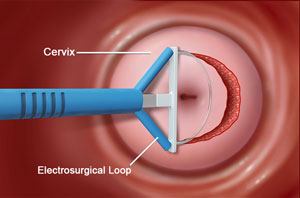LEEP

What is a LEEP?
Loop electrosurgical excision procedure, or LEEP, is a procedure to remove abnormal cells from your cervix or vagina. The procedure is performed by your doctor with the help of a small wire loop. The loop is heated by an electric current to make it similar to a surgical knife to remove cells and tissues from your cervix or vagina.
Indications for a LEEP
Your doctor recommends a LEEP if you Pap smear and tissue sample from your cervix show abnormal cells.
Procedure of LEEP
The procedure takes about 10 to 20 minutes and is usually performed under local anesthesia. Your doctor inserts a speculum inside your vagina for viewing the cervix clearly. An instrument called a colposcope is used to magnify the tissue of your cervix. Iodine or vinegar solution is used to clean the cervix. Your doctor passes the wire loop through the speculum and scrapes away any abnormal tissue. During the process, you may experience slight cramping or may feel some pressure. Tell your doctor immediately if you feel severe pain or feel faint. After the cells are removed, your doctor may apply medication to stop any bleeding.
After the LEEP
You will be able to go home shortly after the procedure. You may experience mild bleeding which is stopped with the help of medication. Avoid strenuous activities, lifting heavy objects, sexual intercourse, douching and using tampons for the first few weeks after the procedure.
Risks and Complications of the LEEP
As with any procedure, the LEEP procedure is associated with certain risks and complications which include:
- Bleeding
- Infection
- Difficulty becoming pregnant
- Giving birth to a premature baby
- Cervical changes or scarring in your cervix
Contact your doctor immediately if you observe the following:
- Heavy bleeding
- Bleeding with clots
- Foul-smelling discharge from your vagina
- Fever
- Severe abdominal pain
Related Topics
- Colpocleisis
- Pessary Fitting
- Clomid/Letrazole
- Uterine Septoplasty
- Office Hysteroscopy
- Cervical Biopsy
- Colposcopy
- Endometrial Ablation
- Endometrial Biopsy
- Excision of endometriosis
- Laparoscopy
- Hormone Replacement Therapy (HRT)
- Hysterectomy
- Hysteroscopy
- Intrauterine Device (IUD)
- Laparoscopic Ovarian Cystectomy
- LEEP
- Mona Lisa Touch
- Myomectomy
- Nexplanon
- Pre-conception Planning
- Robotic-Assisted Gynecology Surgery
- Sterilizations
- In-office Ultrasound
- In-office Procedures
